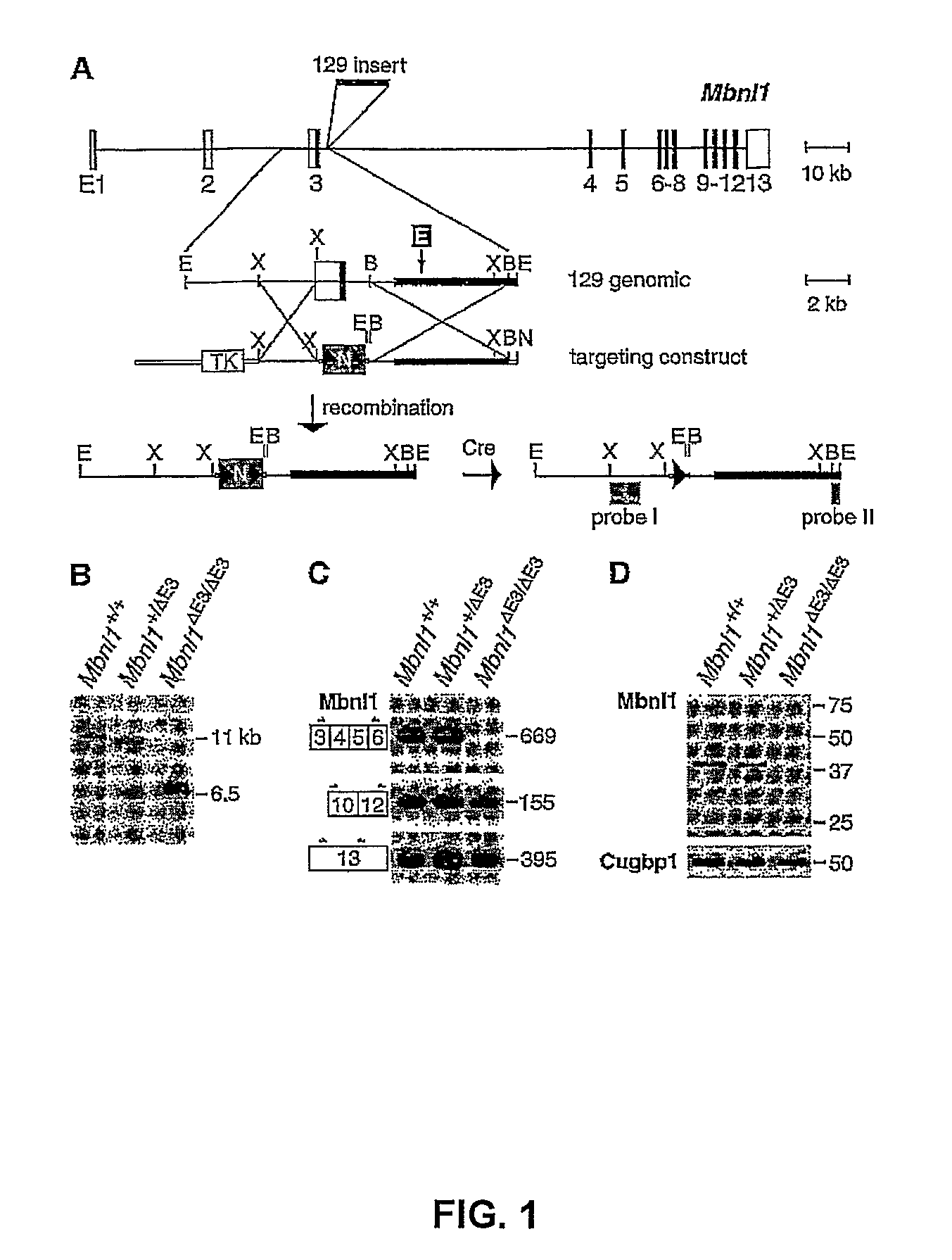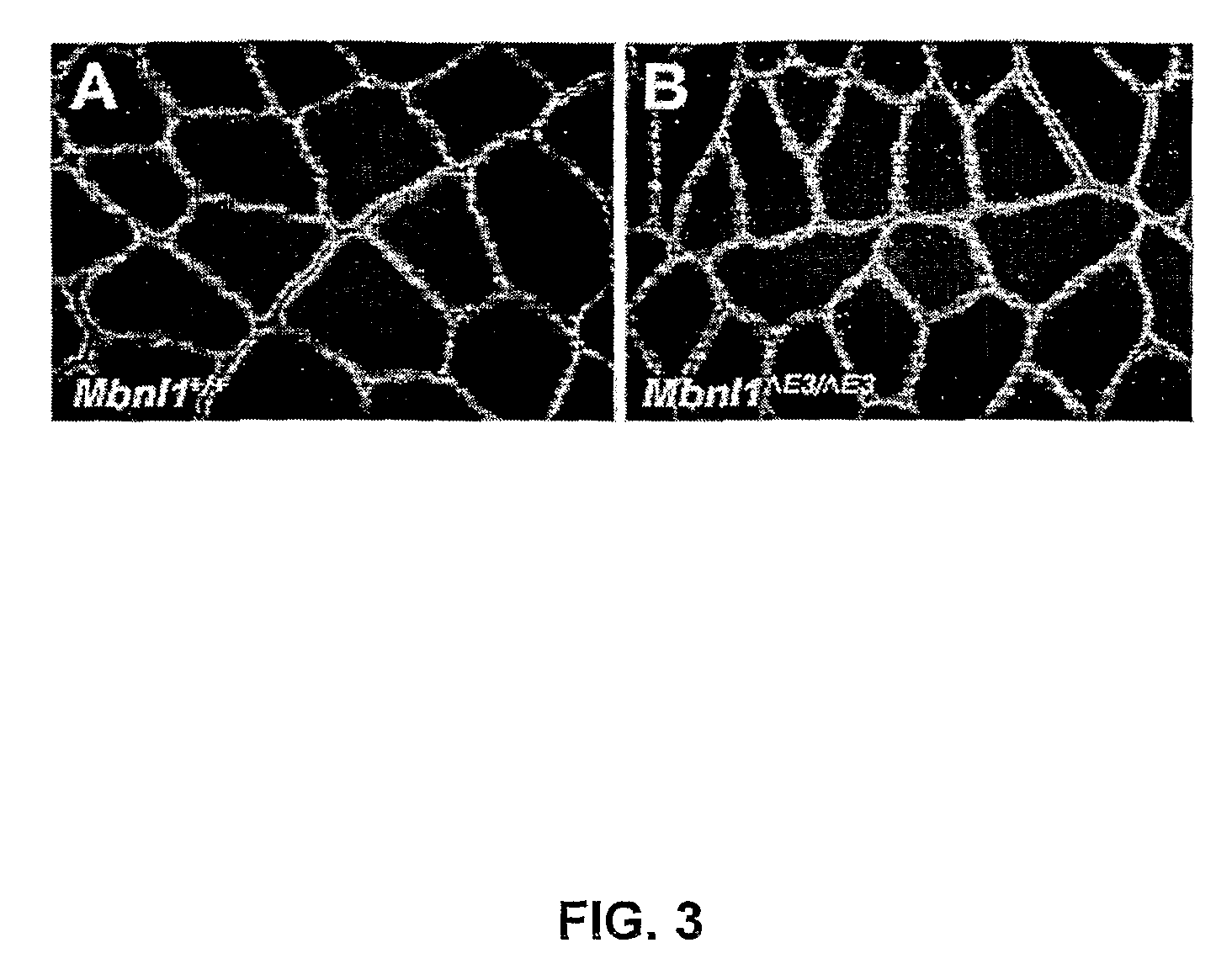Methods and compositions for treatment of myotonia
a technology of myotonia and compositions, applied in the field of methods and compositions for treating myotonia, can solve the problems of human disease, inappropriate expression of fetal protein isoforms for adult tissues, and inappropriate expression of splicing patterns
- Summary
- Abstract
- Description
- Claims
- Application Information
AI Technical Summary
Benefits of technology
Problems solved by technology
Method used
Image
Examples
example 1
Characterization of Mbnl1ΔE3 / ΔE3 Mice
[0141]Targeted disruption of Mbnl1: to test whether or not sequestration of MBNL proteins contributes to DM pathogenesis, mice with a targeted deletion of MbnlI exon 3 (E3) (FIG. 1A) were generated. The pMbnl1ΔE3neo targeting plasmid was constructed using pTKflNeo (gift of E. Scott, University of Florida), which contains the Herpes simplex virus-thymidine kinase (HSV-TK) negative selection marker and a loxP-flanked phosphoglycerate kinaseneomycin (PGK-Neo) positive selection cassette. A 2.5 kb Xbal fragment (5′ arm of homology) corresponding to the upstream region bordering Mhnl1 exon 3, was inserted 5′ of PGK-Neo. For the 3′ arm of homology, a 6 kb Mbnl1 BamHI fragment was subcloned into pBluescript II KS+ (Stratagene, La Jolla, Calif.), excised with XhoI / NotI, and cloned into the XhoI / NotI sites of pTKflNeo 3′ of PGK-Neo.
[0142]The pMbnl1ΔE3neo plasmid was linearized with NotI and electroporated into CJ.7 ES cells (P. J. Swiatek, T. Gridley, Gen...
example 2
[0150]Electromyography: electromyography was performed under general anesthesia (intraperitoneal ketamine, 100 mg / kg; xylazine, 10 mg / kg; and acepromazine, 3 mg / kg) using 30 gauge concentric needle electrodes to examine three hindlimb (tibialis anterior, gastrocnemius, vastus), two forelimb (flexor compartment of distal forelimb, triceps), and thoracolumbar paraspinal muscles. At least 10 needle insertions were performed in each muscle and myotonic discharges were graded on a 4 point scale: 0, no myotonia; 1, occasional myotonic discharge in 50% of insertions; and 3, myotonic discharge with nearly all insertions. The mean score across all Mbnl1ΔE3 / ΔE3 limb muscles was 2.9 in mice age 7 to 11 weeks (n=10). Myotonic discharges were not observed in any muscle in heterozygous Mbnl1+ / ΔE3 mice (n=9) or wild-type littermates (n=9).
[0151]Mbnl1ΔE3 / ΔE3 mice display overt myotonia beginning around 6 weeks of age. Delayed muscle relaxation was most noticeable after a perio...
example 3
Pre-mRNA Splicing
[0161]Abnormal regulation of alternative splicing—Tnnt2: abnormal regulation of alternative splicing has been observed in DM1 muscle for cardiac troponin T (TNNT2), insulin receptor (INSR), and ClC-1. Tnnt2 was analyzed using exon 2 forward (5′GCCGAGGAGGTGGTGGAGGAGTA-3′) (SEQ ID NO: 19) exon 6 reverse (5′GTCTCAGCCTCACCCTCAGGCTCA-3′) (SEQ ID NO: 20) and 27 PCR cycles (45 sec at 96° C., 45 sec at 58° C. and 45 sec at 72° C., followed by a final 10-min extension at 72° C.). Analysis of INSR is uninformative because human patterns of INSR alternative splicing are not conserved in mice. However, Mbnl1ΔE3 / ΔE3 adult heart shows abnormal retention of the Tnnt2 “fetal” exon 5 (FIG. 4A), as was observed for DM1.
[0162]Abnormal regulation of alternative splicing—Tnnt3: to determine whether alternative splicing of other genes is disrupted in Mbnl1ΔE3 / ΔE3, fast skeletal muscle troponin T (Tnnt3) was assessed. For mouse Tnnt3, the forward primer overlaps exons 2 and 3 (5′TCTGACGAG...
PUM
| Property | Measurement | Unit |
|---|---|---|
| volume | aaaaa | aaaaa |
| volume | aaaaa | aaaaa |
| volume | aaaaa | aaaaa |
Abstract
Description
Claims
Application Information
 Login to View More
Login to View More - R&D
- Intellectual Property
- Life Sciences
- Materials
- Tech Scout
- Unparalleled Data Quality
- Higher Quality Content
- 60% Fewer Hallucinations
Browse by: Latest US Patents, China's latest patents, Technical Efficacy Thesaurus, Application Domain, Technology Topic, Popular Technical Reports.
© 2025 PatSnap. All rights reserved.Legal|Privacy policy|Modern Slavery Act Transparency Statement|Sitemap|About US| Contact US: help@patsnap.com



